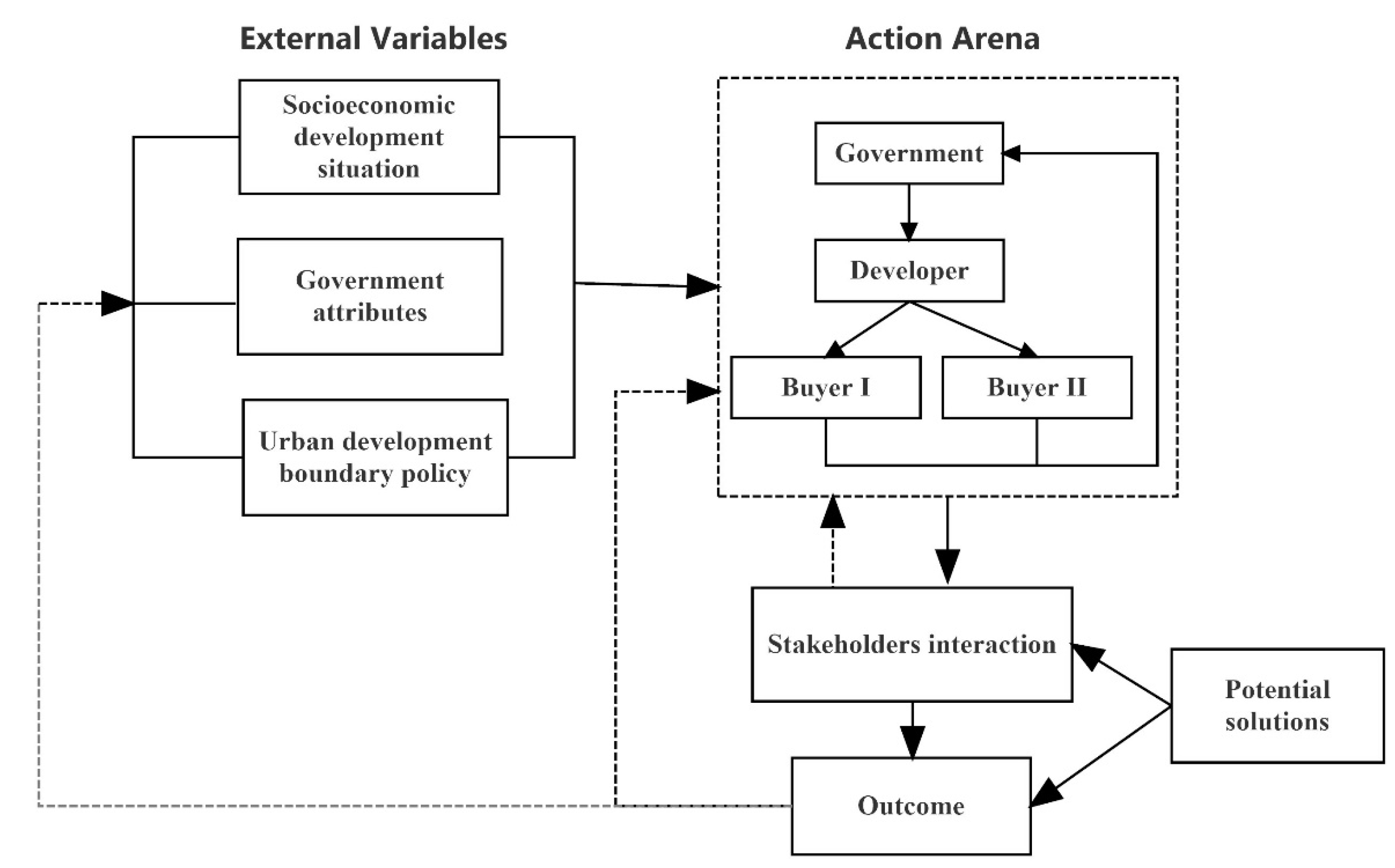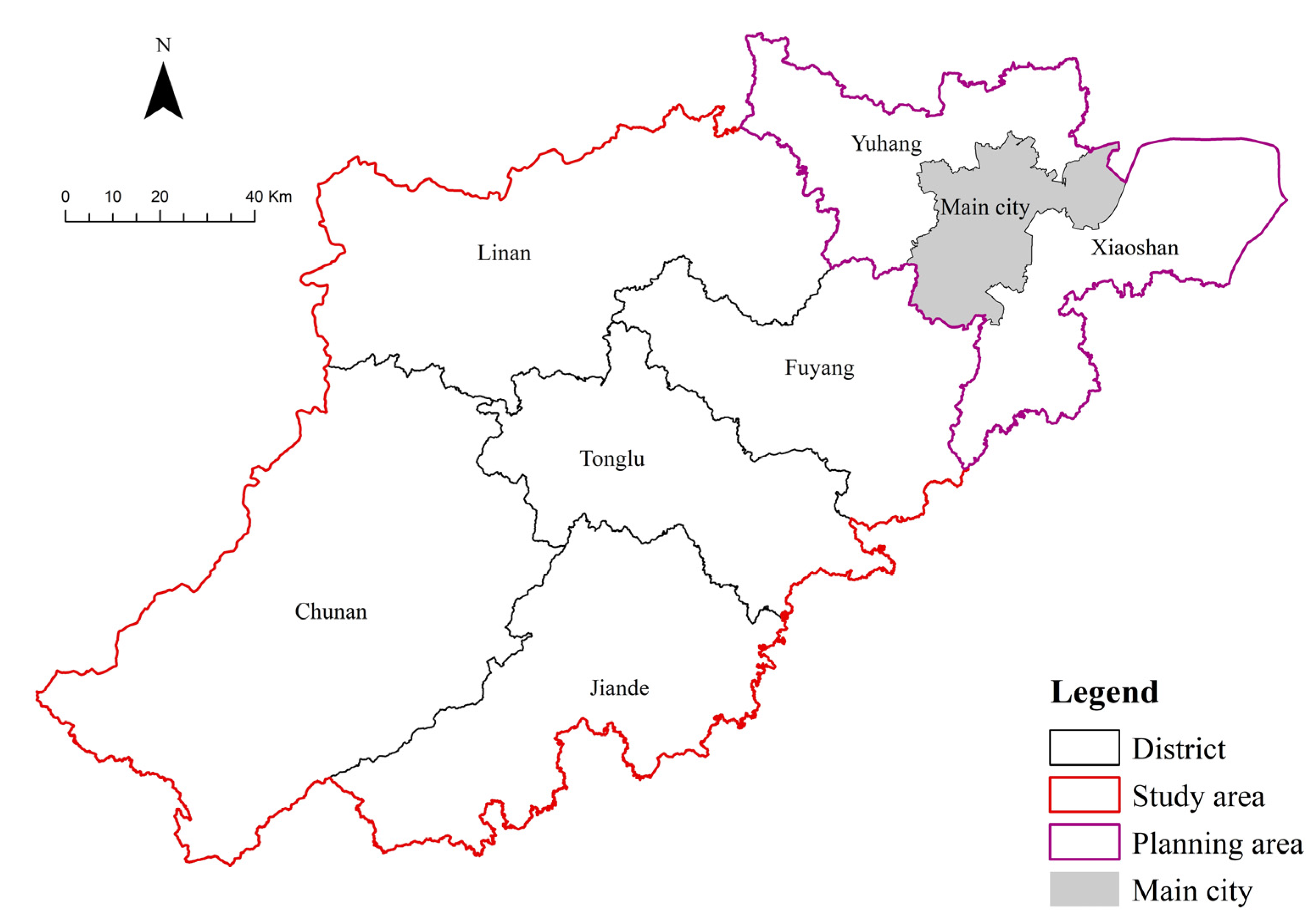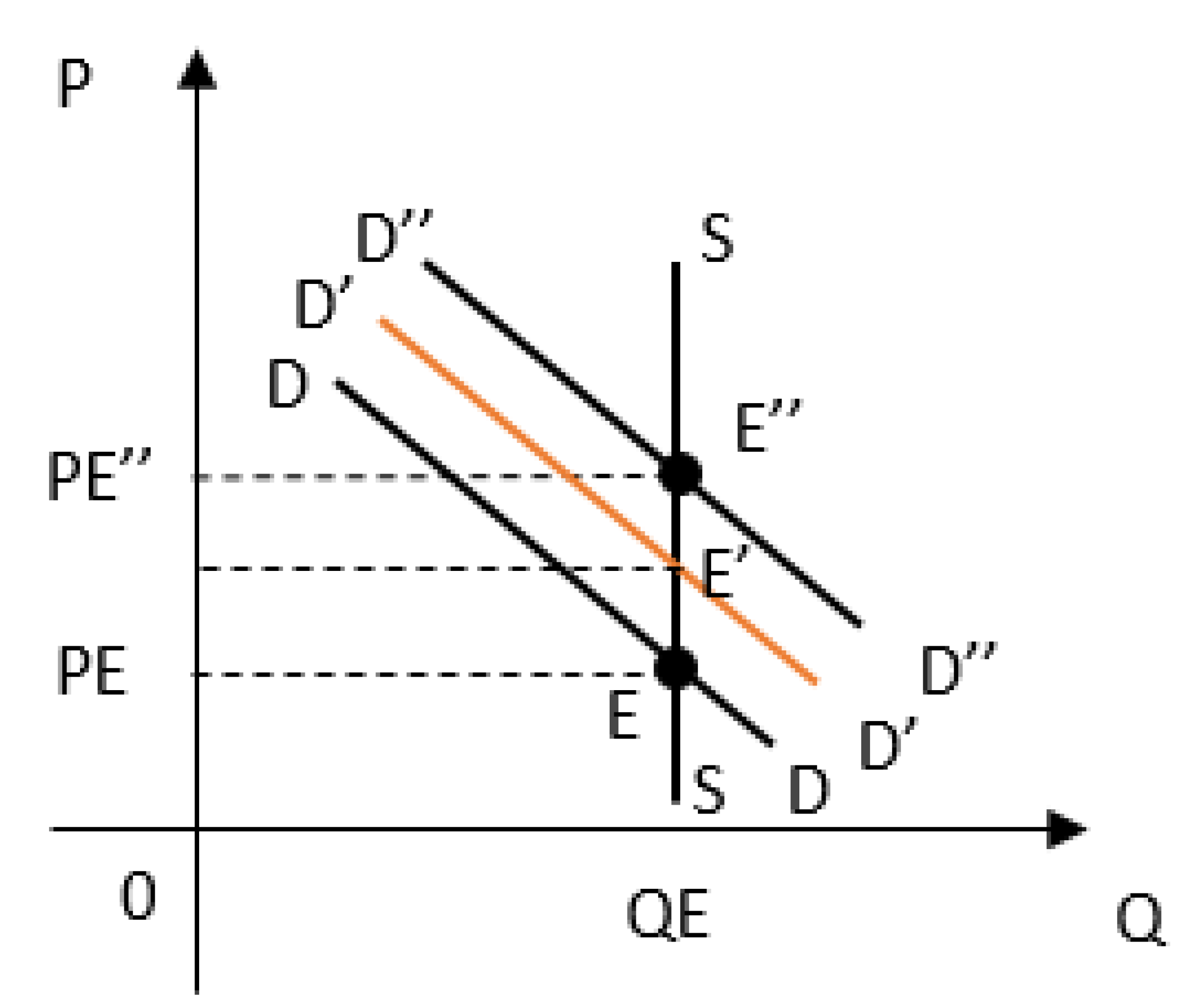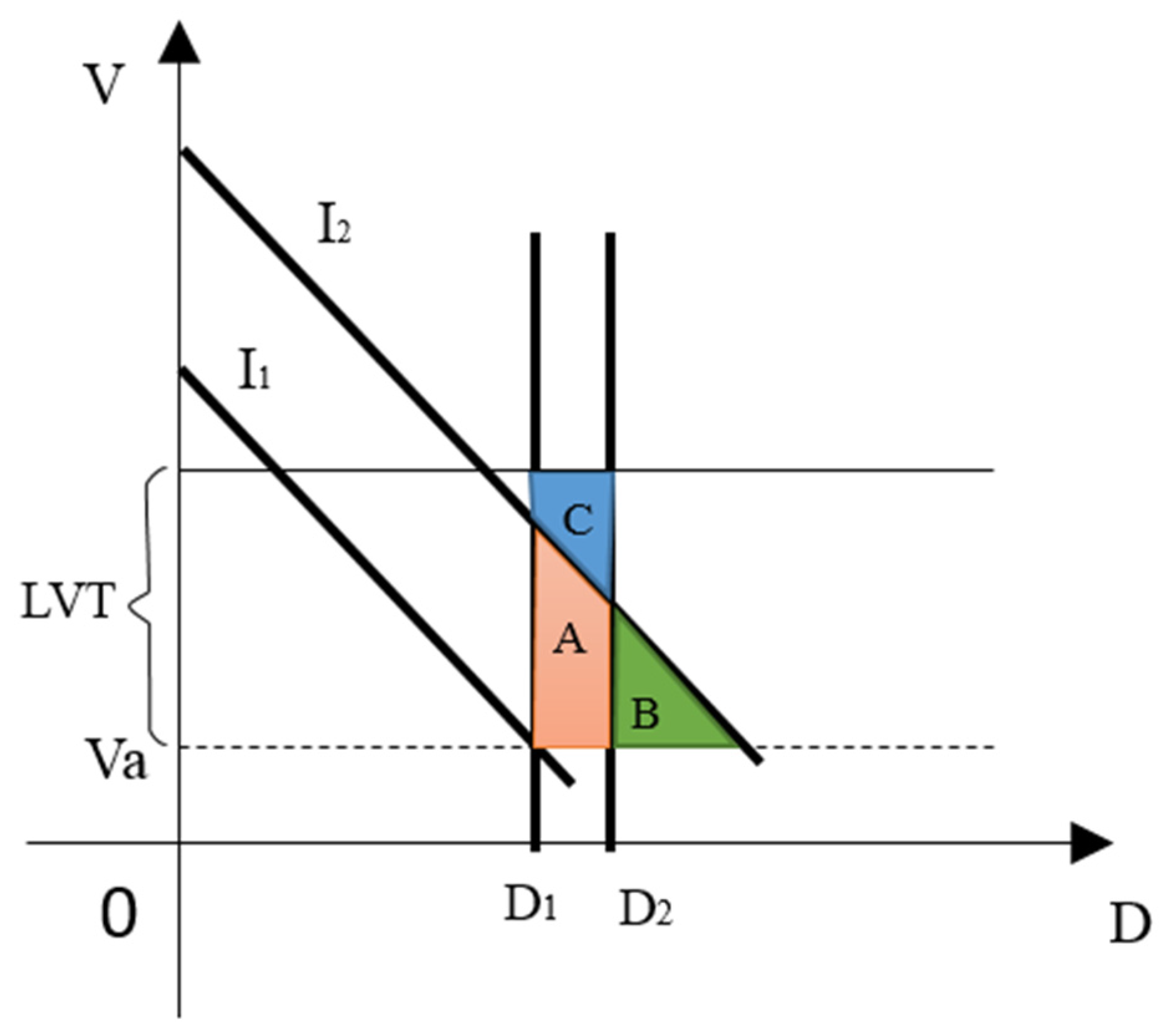Analysis of an Urban Development Boundary Policy in China Based on the IAD Framework
Abstract
1. Introduction
2. Methods and Materials
2.1. Action Arena Design
2.2. IAD Framework Materialization
3. Case Study
3.1. Object of Study
3.2. Exogenous Variables
3.2.1. Socioeconomic Development Situation
3.2.2. Government Attributes
3.2.3. Urban Development Boundary Policy
3.3. Interactions in the Action Arena
3.3.1. Actors
3.3.2. Formal Stage: Goals and Conflicts of the Government
3.3.3. Informal Stage: Goals and Conflicts of Developers and Type I and II Homebuyers
3.4. Results of the Interactions
3.4.1. Potential Fiscal Crisis
3.4.2. Potential Escalating Housing Prices
3.4.3. Potential Illegal Construction Outside of the Urban Boundary
4. Discussion
4.1. Inside the Border: Restricting Industrial Land Transfer
4.2. Outside the Border: Introducing a Land Value Tax
5. Conclusions
Author Contributions
Funding
Institutional Review Board Statement
Informed Consent Statement
Data Availability Statement
- More information available at http://www.gov.cn/govweb/gzdt/2014-01/13/content_2565170.htm (accessed on 1 May 2021).
- More information available at https://modernfarmer.com/2016/09/portland-urban-growth-boundary/ (accessed on 1 June 2021).
Acknowledgments
Conflicts of Interest
References
- Mao, X.; Huang, X.; Song, Y.; Zhu, Y.; Tan, Q. Response to urban land scarcity in growing megacities: Urban containment or inter-city connection? Cities 2020, 96, 102399. [Google Scholar] [CrossRef]
- Dockerill, B.; Sturzaker, J. Green belts and urban containment: The Merseyside experience. Plan Perspect 2019, 35, 583–608. [Google Scholar] [CrossRef]
- Ellison, N. Politics, power and policy transfer. J. Asian Public Policy 2017, 10, 8–24. [Google Scholar] [CrossRef]
- Millward, H. Urban containment strategies: A case-study appraisal of plans and policies in Japanese, British, and Canadian cities. Land Use Policy 2006, 23, 473–485. [Google Scholar] [CrossRef]
- Han, H.; Lai, S.; Dang, A.; Tan, Z.; Wu, C. Effectiveness of urban construction boundaries in Beijing: An assessment. J. Zhejiang Univ.-Sci. A 2009, 10, 1285–1295. [Google Scholar] [CrossRef]
- Kline, J.D.; Thiers, P.; Ozawa, C.P.; Yeakley, J.A.; Gordon, S.N. How well has land-use planning worked under different governance regimes? A case study in the Portland, OR-Vancouver, WA metropolitan area, USA. Landsc. Urban Plan. 2014, 131, 51–63. [Google Scholar] [CrossRef]
- Goodling, E.; Green, J.; McClintock, N. Uneven development of the sustainable city: Shifting capital in Portland, Oregon. Urban Geogr. 2015, 36, 504–527. [Google Scholar] [CrossRef]
- Yep, R.; Fong, C. Land conflicts, rural finance and capacity of the Chinese state. Public Admin. Dev. 2009, 29, 69–78. [Google Scholar] [CrossRef]
- Samat, N.; Mahamud, M.A.; Tan, M.L.; Maghsoodi Tilaki, M.J.; Tew, Y.L. Modelling land cover changes in peri-urban areas: A case study of george town conurbation, Malaysia. Land 2020, 9, 373. [Google Scholar] [CrossRef]
- Ma, S.; Li, X.; Cai, Y. Delimiting the urban growth boundaries with a modified ant colony optimization model. Comput. Environ. Urban Syst. 2017, 62, 146–155. [Google Scholar] [CrossRef]
- He, Q.; Song, Y.; Liu, Y.; Yin, C. Diffusion or coalescence? Urban growth pattern and change in 363 Chinese cities from 1995 to 2015. Sustain. Cities Soc. 2017, 35, 729–739. [Google Scholar] [CrossRef]
- Abbott, C.; Margheim, J. Imagining Portland’s urban growth boundary: Planning regulation as cultural icon. J. Am. Plan. Assoc. 2008, 74, 196–208. [Google Scholar] [CrossRef]
- Cho, S.-H.; Chen, Z.; Yen, S.T.; Eastwood, D.B. Estimating effects of an urban growth boundary on land development. J. Agric. Appl. Econ. 2006, 38, 287–298. [Google Scholar] [CrossRef]
- Tayyebi, A.; Pijanowski, B.C.; Tayyebi, A.H. An urban growth boundary model using neural networks, GIS and radial parameterization: An application to Tehran, Iran. Landsc. Urban Plan 2011, 100, 35–44. [Google Scholar] [CrossRef]
- Bae, C.-H.C.; Jun, M.-J. Counterfactual planning: What if there had been no greenbelt in Seoul? J. Plan. Educ. Res. 2003, 22, 374–383. [Google Scholar] [CrossRef]
- Nelson, A.C. An empirical note on how regional urban containment policy influences an interaction between greenbelt and exurban land markets. J. Am. Plan. Assoc. 1988, 54, 178–184. [Google Scholar] [CrossRef]
- Jeon, J.S. How housing market responds to greenbelt relaxation: Case of Seoul Metropolitan Area, South Korea. Land Use Policy 2019, 84, 328–334. [Google Scholar] [CrossRef]
- Jun, M.-J.; Kim, H.-J. Measuring the effect of greenbelt proximity on apartment rents in Seoul. Cities 2017, 62, 10–22. [Google Scholar] [CrossRef]
- Mathur, S. Impact of an urban growth boundary across the entire house price spectrum: The two-stage quantile spatial regression approach. Land Use Policy 2019, 80, 88–94. [Google Scholar] [CrossRef]
- Mossberger, K.; Wolman, H. Policy transfer as a form of prospective policy evaluation: Challenges and recommendations. Public Admin. Rev. 2003, 63, 428–440. [Google Scholar] [CrossRef]
- Evans, M. Understanding policy transfer. In Policy Transfer in Global Perspective; Routledge: London, UK, 2017; pp. 10–42. [Google Scholar]
- Bengston, D.N.; Fletcher, J.O.; Nelson, K.C. Public policies for managing urban growth and protecting open space: Policy instruments and lessons learned in the United States. Landsc. Urban Plan. 2004, 69, 271–286. [Google Scholar] [CrossRef]
- Chen, W.; Shen, Y.; Wang, Y.; Wu, Q. How do industrial land price variations affect industrial diffusion? Evidence from a spatial analysis of China. Land Use Policy 2018, 71, 384–394. [Google Scholar] [CrossRef]
- Long, Y.; Han, H.; Tu, Y.; Shu, X. Evaluating the effectiveness of urban growth boundaries using human mobility and activity records. Cities 2015, 46, 76–84. [Google Scholar] [CrossRef]
- Zhang, D.; Liu, X.; Lin, Z.; Zhang, X.; Zhang, H. The delineation of urban growth boundaries in complex ecological environment areas by using cellular automata and a dual-environmental evaluation. J. Clean. Prod. 2020, 256, 120361. [Google Scholar] [CrossRef]
- Zhang, Z.; Zhang, S. The ideas and methods of spatial structure-oriented urban growth boundary delimitation—A case study of Hangzhou City. Urban Plan. Forum 2013, 4, 33–41. (In Chinese) [Google Scholar]
- Zhang, X.; Lin, Y.; Wu, Y.; Skitmore, M. Industrial land price between China’s Pearl River Delta and Southeast Asian regions: Competition or coopetition? Land Use Policy 2017, 61, 575–586. [Google Scholar] [CrossRef]
- Ostrom, E. Institutional rational choice: An assessment of the institutional analysis and development framework. In Theories of the Policy Process; Routledge: New York, NY, USA, 2019; pp. 21–64. [Google Scholar]
- Barreteau, O. Working Together: Collective Action, the Commons, and Multiple Methods in Practice, by Poteete, Amy, R., Janssen, Marco A. and Ostrom, Elinor. J. Artif. Soc. Soc. Simul. 2011, 14, 2. [Google Scholar]
- Dawkins, C.J.; Nelson, A.C. Urban containment policies and housing prices: An international comparison with implications for future research. Land Use Policy 2002, 19, 1–12. [Google Scholar] [CrossRef]
- Zhou, G.; He, Y. Characteristics and Influencing Factors of Urban Land Expansion in Changsha. Acta Geogr. Sin. 2006, 61, 1171–1180. (In Chinese) [Google Scholar]
- Gao, X.; Zhang, A.; Sun, Z. How regional economic integration influence on urban land use efficiency? A case study of Wuhan metropolitan area, China. Land Use Policy 2020, 90, 104329. [Google Scholar] [CrossRef]
- Kim, S.; Jung, C. The Influence of Urban Planning-Related Pledge Budget on Local Election Votes: A City Case in Korea. Land 2020, 9, 493. [Google Scholar] [CrossRef]
- Liu, Y.; Li, J.; Yang, Y. Strategic adjustment of land use policy under the economic transformation. Land Use Policy 2018, 74, 5–14. [Google Scholar] [CrossRef]
- Huang, Z.; Du, X. Strategic interaction in local governments’ industrial land supply: Evidence from China. Urban. Stud. 2017, 54, 1328–1346. [Google Scholar] [CrossRef]
- Bao, H.; Peng, Y. Effect of land expropriation on land-lost farmers’ entrepreneurial action: A case study of Zhejiang Province. Habitat Int. 2016, 53, 342–349. [Google Scholar] [CrossRef]
- Bondar, O. Public administration in the field of land use and protection and state land policy in Ukraine: Problems of correlation. Balt. J. Econ. Stud. 2018, 4, 22–27. [Google Scholar] [CrossRef]
- Ding, C. Land policy reform in China: Assessment and prospects. Land Use Policy 2003, 20, 109–120. [Google Scholar] [CrossRef]
- Cai, Y. Collective ownership or cadres’ ownership? The non-agricultural use of farmland in China. China Quart. 2003, 175, 662–680. [Google Scholar] [CrossRef]
- Seto, K.C.; Fragkias, M.; Güneralp, B.; Reilly, M.K. A meta-analysis of global urban land expansion. PLoS ONE 2011, 6, e23777. [Google Scholar] [CrossRef]
- You, H.; Yang, X. Urban expansion in 30 megacities of China: Categorizing the driving force profiles to inform the urbanization policy. Land Use Policy 2017, 68, 531–551. [Google Scholar] [CrossRef]
- Tao, L. The influence of housing characteristics on rural migrants’ living condition in Beijing Fengtai District. HBRC J. 2015, 11, 252–263. (In Chinese) [Google Scholar] [CrossRef][Green Version]
- Wu, Y.; Luo, J.; Zhang, X.; Skitmore, M. Urban growth dilemmas and solutions in China: Looking forward to 2030. Habitat Int. 2016, 56, 42–51. [Google Scholar] [CrossRef]
- Hsing, Y.-t. Land and territorial politics in urban China. China Quart. 2006, 187, 575–591. [Google Scholar] [CrossRef]
- Gu, Y. The crowded space theory and migrant workers’ urban integration. Urban. Probl. 2015, 7, 90–96. (In Chinese) [Google Scholar]
- Gao, Y.; Tian, L.; Cao, Y.; Zhou, L.; Li, Z.; Hou, D. Supplying social infrastructure land for satisfying public needs or leasing residential land? A study of local government choices in China. Land Use Policy 2019, 87, 104088. [Google Scholar] [CrossRef]
- Wang, C.; Ye, Y.; Fan, M. The Three Relations in UGB Delimitation and Governance—An Analysis Based on the Theory of “Homo-urbanicus”. Urban. Plan. Forum 2021, 1, 28–35. (In Chinese) [Google Scholar]
- Xu, J. The flexibility, scale and mechanism of urban development boundary. Planners 2016, 32, 5–9. (In Chinese) [Google Scholar]
- Cho, S.-H.; Kim, S.G.; Roberts, R.K. Measuring the effects of a land value tax on land development. Appl. Spat. Anal. Policy 2011, 4, 45–64. [Google Scholar] [CrossRef]






| City | Price-to-Income Ratio | Price-to-Rent Ratio—City Center | Price-to-Rent Ratio—Outside of the City Center |
|---|---|---|---|
| Beijing | 48.09 | 76.02 | 61.02 |
| Shanghai | 43.96 | 52.26 | 55.58 |
| Hong Kong | 42.54 | 50.32 | 51.94 |
| Mumbai | 28.65 | 41.83 | 34.61 |
| Hangzhou | 22.96 | 46.59 | 38.64 |
| London | 22.25 | 35.96 | 28.75 |
| Seoul | 20.43 | 56.2 | 56.53 |
| Tokyo | 13.34 | 41.89 | 35.56 |
| New York | 12.46 | 19.09 | 17.38 |
| Portland | 5.11 | 12.04 | 11.27 |
| Initiative of Local Government | Information Cost to Homebuyer II | Purchasing Power of Homebuyer I | Local Financial Revenue Loss | Property Inflation | Illegal Construction | |
|---|---|---|---|---|---|---|
| Original policy | Negative | Decreased | Weak | Severe | Severe | Increased |
| Improved policy | Improved | Increased | Strengthened | Moderate | Moderate | Improved |
Publisher’s Note: MDPI stays neutral with regard to jurisdictional claims in published maps and institutional affiliations. |
© 2021 by the authors. Licensee MDPI, Basel, Switzerland. This article is an open access article distributed under the terms and conditions of the Creative Commons Attribution (CC BY) license (https://creativecommons.org/licenses/by/4.0/).
Share and Cite
Luo, J.; Wang, W.; Wu, Y.; Peng, Y.; Zhang, L. Analysis of an Urban Development Boundary Policy in China Based on the IAD Framework. Land 2021, 10, 855. https://doi.org/10.3390/land10080855
Luo J, Wang W, Wu Y, Peng Y, Zhang L. Analysis of an Urban Development Boundary Policy in China Based on the IAD Framework. Land. 2021; 10(8):855. https://doi.org/10.3390/land10080855
Chicago/Turabian StyleLuo, Jiaojiao, Wei Wang, Yuzhe Wu, Yi Peng, and Linlin Zhang. 2021. "Analysis of an Urban Development Boundary Policy in China Based on the IAD Framework" Land 10, no. 8: 855. https://doi.org/10.3390/land10080855
APA StyleLuo, J., Wang, W., Wu, Y., Peng, Y., & Zhang, L. (2021). Analysis of an Urban Development Boundary Policy in China Based on the IAD Framework. Land, 10(8), 855. https://doi.org/10.3390/land10080855








